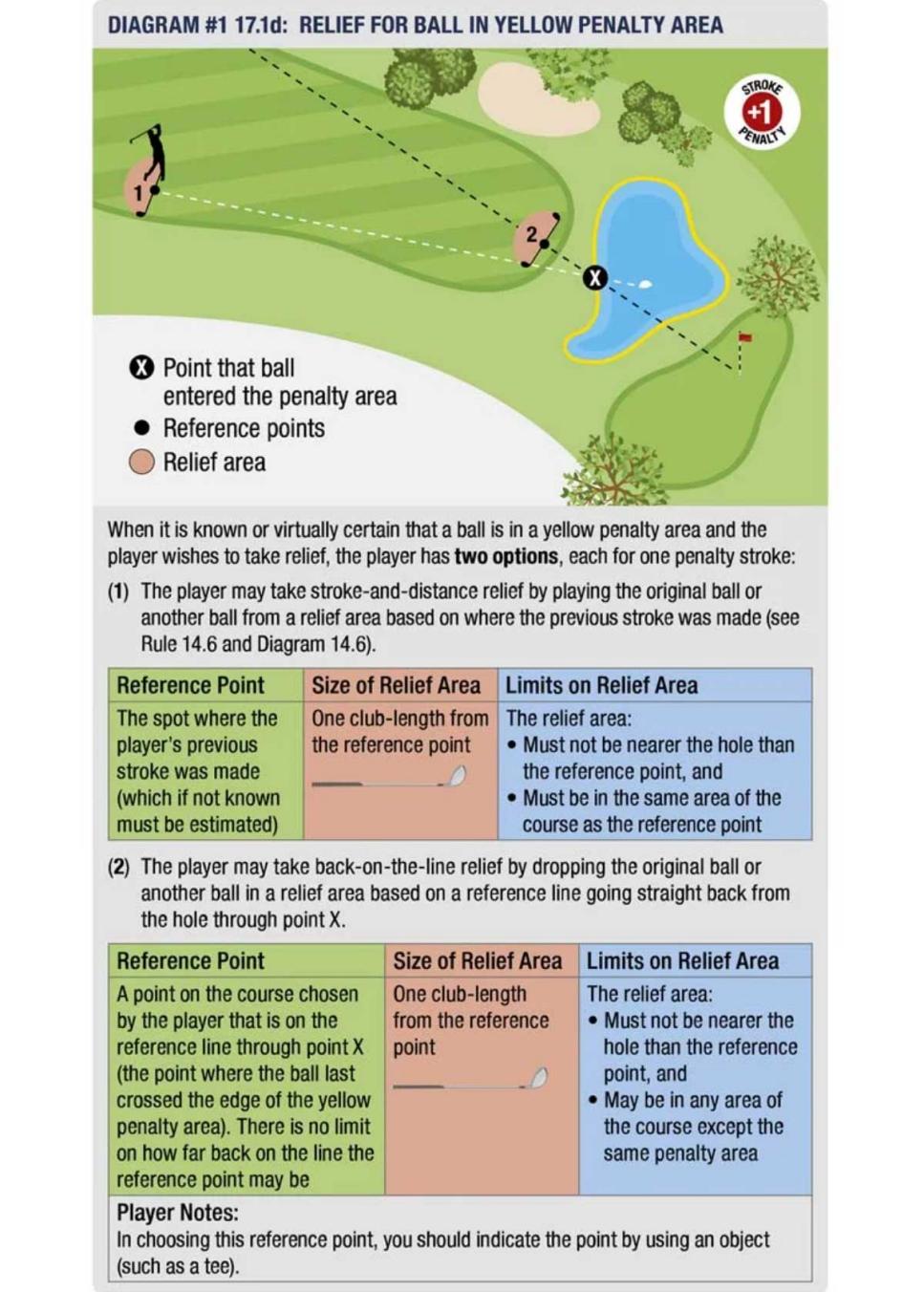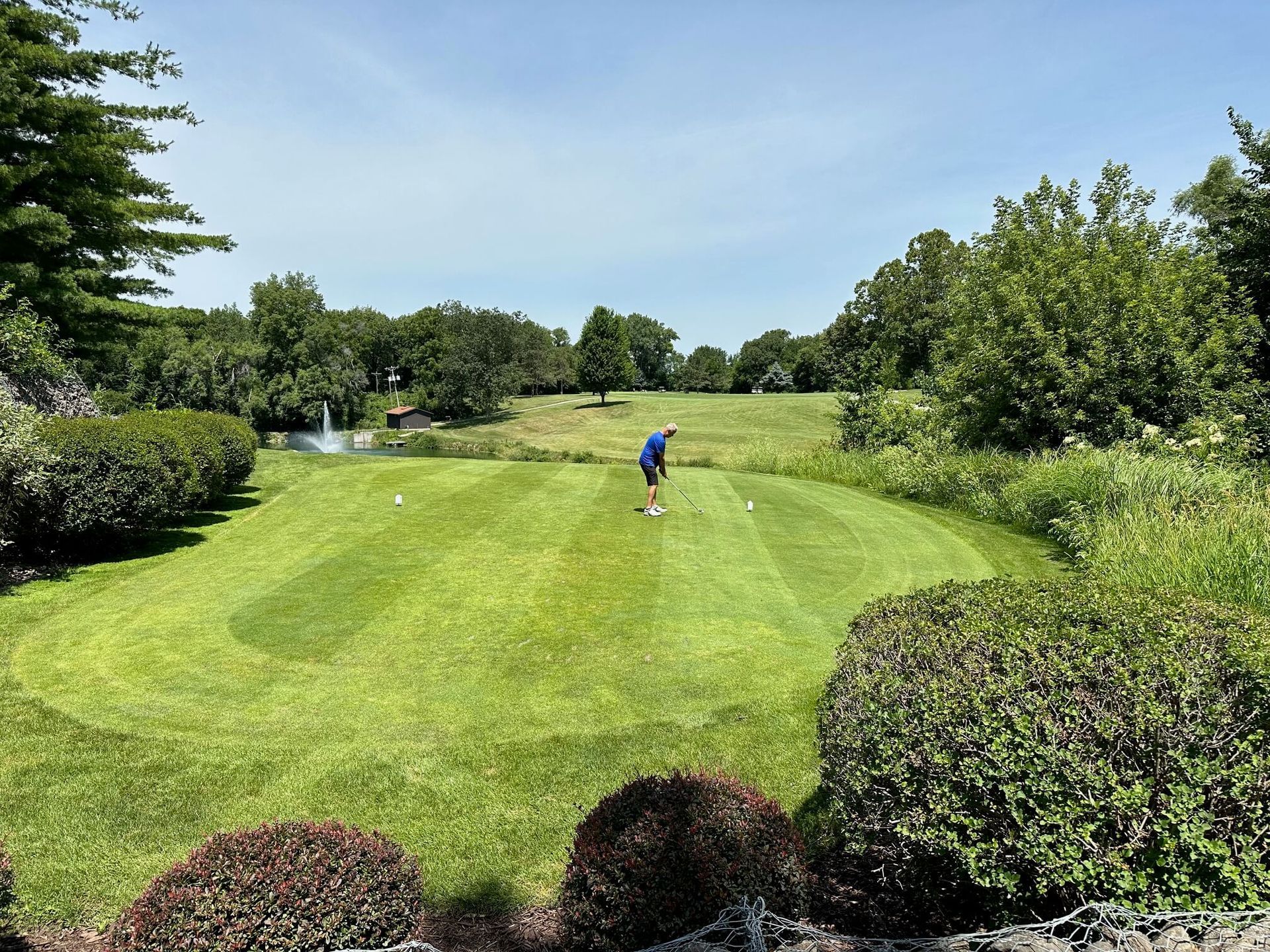A Guide to the Rules of Golf, Scoring, Playing Formats, & Etiquette
Written by: Tony Schwartz
Last Updated: January 11, 2024
Golf, often referred to as the "gentleman's game," is a sport that blends skill, strategy, and sportsmanship into one beautiful and challenging package. Whether you're new to golf or have been intrigued by it for a while, understanding the basic rules of golf is essential for an enjoyable experience on the course. In this comprehensive guide, we'll explore the fundamental concepts of golf, learn how to keep score in stroke play, delve into the basic concept of a golf scramble, and shed light on some key golf rules, including the dreaded "out of bounds" rule.
Please keep in mind that we've developed this beginner's guide for someone who is new to their journey with golf and the rules of golf. At Planet Divot, we are committed to bringing the most comprehensive information and guides for the game of golf to our readers. As we get further into this journey together, Planet Divot will be creating more detailed guides on the rules of golf for intermediate and even advanced players.
Getting Started with the Rules of Golf
Golf Essentials
Before you hit the course, it's important to familiarize yourself with the essential equipment and terminology used in golf. We've created a comprehensive guide for you to explore types of golf clubs on Planet Divot in addition to a comprehensive guide to golf terms in case you would like a more in-depth and detailed understanding of each.
Golf Clubs: Golfers use a variety of clubs, each designed for specific shots. The main types include drivers, hybrids, irons, wedges, and putters.
Golf Ball: Golf balls come in various types, each with unique characteristics. Novices usually start with two-piece or three-piece balls.
Tee: A tee is a small peg that holds the golf ball in place for your first shot on each hole.
Golf Bag: Your clubs will be carried in a golf bag. Choose one that suits your needs, whether it's a stand bag, cart bag, or carry bag.
Golf Course: A standard golf course comprises 18 holes, each with its unique layout and challenges. Courses can vary in difficulty.
Basic Golf Etiquette: Respect other players by observing golf etiquette. This includes not talking or moving during a player's golf swing and repairing divots and ball marks on the green.
The Objective: Getting the Ball in the Hole
The primary objective in golf is simple: get the ball into the hole in as few strokes as possible. Each hole has a designated starting point, known as the tee box, and a finishing point, which is the hole on the green. The fewer strokes it takes you to complete a hole, the better your score. In our guide to golf terms we explore golf scoring systems.
Understanding Stroke Play
In stroke play, the most common form of golf, your goal is to complete each hole in as few strokes as possible. Your score for each hole is the total number of strokes it takes you to get the ball into the hole. Here's how to keep score:
- Par: Each hole on a golf course has a predetermined number of strokes called par. Par represents the ideal number of strokes a skilled golfer should take to complete the hole. For example, a par-3 hole should be completed in three strokes, while a par-5 hole should be completed in five strokes.
- Scorecard: Every golfer carries a scorecard, which lists the holes on the course and provides space to record your scores. These days, scorecards can be physical paper or digitally tracked using services like 18Birdies.
- Counting Strokes: After each hole, write down the number of strokes it took you to complete it on your scorecard.
- Calculating Your Score: To calculate your total score for a round of golf, add up the number of strokes for each hole. The lower the score, the better.
Handicaps
Golfers of different skill levels can compete fairly using a handicap system. A handicap is a numerical representation of a player's skill level, with lower handicaps indicating better players. Handicaps are used to adjust scores and level the playing field. Golf courses usually have a course rating and slope rating, which help determine a player's handicap index.
What is a Golf Scramble?
A golf scramble is a fun and social format of playing golf that's popular among beginners and experienced golfers alike. It's often used in team events and tournaments. In a scramble, players form teams, and each team hits a tee shot. From there, the team chooses the best tee shot and all players hit from that spot. This process continues until the ball is in the hole. Here's how a typical golf scramble works:
- Team Formation: Usually, teams consist of two to four players.
- Tee Shot: Each team selects one player's tee shot to use as the starting point. This can be the best or most strategically placed shot.
- Subsequent Shots: All players on the team hit their next shots from the location of the chosen tee shot.
- Repeat: This process continues until the ball is holed out. The team's score is the total number of strokes it takes to complete the round.
Golf scrambles are a great way for beginners to ease into the game because they can rely on the skills of their more experienced teammates. They also encourage teamwork and can be a lot of fun. Keep in mind that this style of play varies from stroke play in that you would not know your true final score after completing the round. For some, that's an important nuance. For others looking to get out, play some golf, and enjoy a casual round, a scramble is a great way to make that happen!
Deepening an Understanding of Golf Rules
The game of golf is governed by a comprehensive set of rules, established and maintained by the United States Golf Association (USGA) and the R&A (the governing body for golf outside the United States and Mexico). While there are many rules in golf, here are some fundamental ones that every golfer should be aware of:
- Observe Pace of Play: Play at a reasonable pace and be mindful of other golfers on the course. Slow play can lead to penalties or being asked to pick up the pace.
- No Disturbance During Swings: Avoid distractions and remain still when other players are making their swings.
- Out of Bounds: Golf courses have boundaries known as out of bounds (OOB or "OB"). If your ball goes OOB, you must re-hit from where you played your last shot with a one-stroke penalty.
- Hazard Areas: Hazard areas, such as water hazards and bunkers, have specific rules. When your ball is in a hazard, you may have to take a penalty or make specific drops.
- Lost Ball: If you can't find your ball after searching for 3-5 minutes, it's considered lost, and you must take a penalty stroke and re-hit from where you last played.
- Grounding the Club: In certain conditions, touching the ground with your club before hitting the ball can result in penalties, especially in hazard areas.
- Unplayable Lie: If your ball is in an unplayable position (e.g., in heavy rough, behind a tree), you can take relief with a penalty stroke.
- Gimme Putts: In casual play, players sometimes concede short putts to one another. This is known as a "gimme." In competitive rounds, gimmes are not allowed and considered illegal.
USGA Rules of Golf
The USGA Rules of Golf are the official rules governing the sport in the United States. While the basic principles are consistent worldwide, the USGA has made some modifications and clarifications for American golfers. It's important to familiarize yourself with these rules if you're playing in the United States. You can find the complete USGA Rules of Golf on the USGA website.
Golf Out of Bounds Rule
The out of bounds (OOB) rule can be one of the most challenging and frustrating aspects of golf, especially for beginners. When your ball goes OOB, it means it has crossed the course's boundaries and is considered out of play. Here's how to handle OOB situations:
- One-Stroke Penalty: When your ball goes OOB, you must add a one-stroke penalty to your score.
- Replay the Shot: After adding the penalty stroke, you must re-hit from the same spot where you originally played the shot that went OOB.
- Provisional Ball: To save time, you have the option to play a provisional ball (an extra ball) before searching for your original ball. If your original ball is found in bounds, you can continue playing it. If not, you continue with your provisional ball, adding the one-stroke penalty.
- Time Limit: You have five minutes to search for your ball before it's considered lost.
Let's Understand Golf's Core Objective
Golf is a nuanced game where players aim to complete each hole in as few strokes as possible, navigating through diverse landscapes, hazards, challenges, and opportunities along the way. A golfer's success hinges on their ability to judge distances accurately, select the appropriate club for each shot, and execute their shots with precision. Every hole presents a unique test, with its own set of hazards and layout, pushing players to constantly adapt their strategies and test their skills. To summarize the core objective on every hole of golf, it is to finish the hole in as few of shots as possible.
Understanding Golf Equipment
Your bag, limited to 14 golf clubs, should contain a mix of woods, hybrids, irons, wedges, and a putter, each serving their own purpose and supporting various situations on the golf course. Woods are designed for long-distance shots, irons vary in loft for mid-range shots, wedges are ideal for short distances and high precision, and the putter is key for the green. Choosing the right club based on the situation is a critical skill. The golf ball, conforming to official standards, often varies in design to suit different playing styles, but beginners should focus on durability and control. If you're looking for the best golf ball we tested, we've got you covered!
Play Formats Explored
Golf can be played in a few main formats: stroke play, match play, and scramble. In stroke play, the total number of strokes across the course determines the winner, making consistent performance across all holes vital. Match play, on the other hand, is a hole-by-hole competition where the total number of holes won decides the victor. This format adds a psychological layer to the game, as players must adapt to the evolving dynamics of each hole against their opponent. The scramble can have a variety of rules that apply. Here's a great guide to best ball vs. scramble in golf.
Tee Box Strategies
The tee box is where every hole begins, and strategic use of this area can give players an advantage. Positioning your tee within the designated area, which can be tactically chosen based on the hole's layout, affects the angle and approach of your first shot. The height at which the ball is teed, especially when using a driver, can also significantly influence the distance and trajectory of the shot. This is the only location on the course where you can use a tee, tee the ball up, and take your shot. In general, using a tee can make it easier to make contact with the ball.
The Essence of Golf Etiquette
Golf is steeped in traditions of sportsmanship and respect. This includes maintaining a steady pace of play, allowing faster groups to play through, and observing silence and stillness when others are taking their shots. Additionally, players are expected to care for the course, such as repairing divots and smoothing bunkers, preserving the quality of play for everyone.
Confronting Course Challenges
On the course, players often encounter hazards like water and bunkers. Each type of hazard has specific rules regarding ball retrieval and penalties. For instance, water hazards are marked by yellow or red stakes, guiding players on where they can drop a new ball with a penalty. In bunkers, players must avoid grounding their club before the shot, adding to the challenge of these sandy traps.
Scoring in Golf
Scoring in golf is a straightforward yet critical aspect of the game. Terms like 'birdie' (one under par) and 'bogey' (one over par) are part of the golfing lexicon, reflecting a player's performance relative to the expected number of strokes for a hole. A consistent approach to each hole is crucial in stroke play, as high scores on any single hole can significantly impact the overall score.
Handling Difficult Situations on the Golf Course
When dealing with lost balls or unplayable lies, knowledge of the rules is key. Players have a limited time to search for a lost ball, typically three minutes, after which the ball is considered lost, and a penalty is applied. For unplayable lies, options include dropping the ball within two club-lengths or taking it back in line with the hole, each carrying specific penalty strokes.
Mastering the Putting Green
On the green, players must read the terrain, understanding how slopes and contours affect the ball's path. Putting requires a blend of precision and mental strength, making practice essential for both short and long putts. The order of play on the green typically follows the distance from the hole, with the farthest player putting first.
Order of Play and Ready Golf
The order of play in golf can be a strategic element, especially in match play. While traditionally the player with the best score on the previous hole tees off first, 'ready golf'—where players hit when ready if it's safe and reasonable—is encouraged to maintain a brisk pace. This approach prioritizes efficiency and can reduce overall playing time.
Navigating Rule Infractions
Golf is a game of integrity, often requiring players to self-regulate and penalize themselves for rule infractions. Common penalties include hitting the wrong ball or playing from the wrong spot. Understanding these rules and applying them honestly is integral to the spirit of the game.
This comprehensive approach to the rules and nuances of golf provides beginners with a solid foundation to start their journey in this challenging and rewarding sport. As you play more, your familiarity with these aspects will grow, enhancing your appreciation and skill in the game.

Provisional Ball Rule Explained
If, after playing a shot, you think your ball may be lost in a hazard, penalty area, OB, or may not be able to be found, then you should take advantage of the provisional ball rule which allows you to play another ball. The best time to play a provisional ball is before you go forward to search for the original ball, especially if it is some 200-250 yards away. Under the official golf rules, if there's a concern that the original ball is lost outside a penalty area or out of bounds, a golfer should declare and play a provisional ball. This action, supported by the R&A Rule 18.3c, is crucial to avoid delays in the game.
However, Clarification 18.3a/2 confirms that the player has up to three minutes from starting their search in which to play a provisional ball, which may come in handy if you've topped it a short distance into thick rough off the tee and are trying desperately to keep an eye on where you think it is, but is unlikely to be practical if you've already searched for, say, two minutes and still have that 250-yard walk to make! In rounds that are less competitive or informal, you may take more than 3 minutes to find your ball, but for the sake of being mindful about your pace of play, it's important to restrict yourself to just a few minutes. As someone who is very committed to finding every shot out there on the golf course, I have taken more than 3 minutes to find my golf ball in the past without incurring any penalties, mostly because the people I was playing with were friends and family. But if I were in competition, 3 minutes would be the maximum allowable time to search (and 3 minutes goes fast!).

What is a Provisional Ball in Golf?
A provisional ball is played when there's a reasonable belief that the original ball might be lost outside a penalty area or out of bounds. This rule, integral to the pace and fairness of the game, must be executed correctly to avoid unnecessary penalties. Below we will go into more detail about the provisional golf ball rule, when to use it, tips, and restrictions associated with the provisional golf ball. We hope this guide helps you better navigate the scenario when you expect your golf ball to be lost and how best to take advantage of the provisional golf ball rule.
When to Use a Provisional Ball
Anticipating a Lost Ball: If you think your original ball is lost out of bounds or in a penalty area, you must inform your playing partners that you intend to play a provisional vocally. It's important that you announce the provisional golf ball that you're playing ahead of doing so so that your playing partners know that you are operating within the rules of the provisional golf ball. After playing your provisional golf ball, you have the opportunity to find your original shot for exactly 3 minutes in a competitive golf environment. If you've not found your original ball then you would move on to play your provisional with a 2-stroke penalty. What was going to be your 2nd shot after your tee ball now becomes your 4th shot. Best to avoid the hazards altogether to keep your scores down!

Playing a Provisional Ball: Planet Divot's Tips for the Rule
- Announcement Protocol: Explicitly announce your intent to play a "provisional" ball. Ambiguous statements like "I’m gonna hit another" are not acceptable. Clear communication is essential to differentiate between a provisional and a stroke-and-distance situation. If someone says "I'm going to hit another" may imply that the golfer intends to use a mulligan which may not be acceptable in the round of golf you're playing. The USGA does not recognize mulligans in the rules of golf.
- Playing Multiple Provisional Balls: The rules allow for playing multiple provisional golf balls under the penalty of stroke and distance if the first provisional ball is expected to be lost. Playing a second provisional ball is conditional, meaning that if you find your first provisional then your strokes will be reflected as such and you will not be penalized for playing an additional provisional ball. That to say, if you think your provisional ball may be lost, do yourself a favor and play another.
- Strategic Continuation: Continue with the provisional ball until it reaches a point nearer to the hole than where the original ball likely is. If the original is found in bounds within three minutes, it must be used; otherwise, the provisional ball is continued.
Key Restrictions When Playing a Provisional
- Provisional Ball in Penalty Areas: You cannot play a provisional ball if you suspect your ball is in a penalty area. In such cases, the 'provisional' becomes your ball in play.
- Provisional Ball Limitations: You cannot hit a provisional ball anytime. It's only permitted when there's a possibility that your original ball is lost outside a penalty area or out of bounds.
